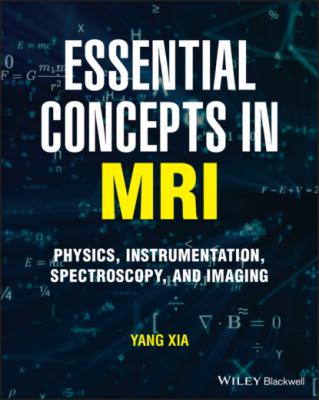ТОП просматриваемых книг сайта:
Essential Concepts in MRI. Yang Xia
Читать онлайн.Название Essential Concepts in MRI
Год выпуска 0
isbn 9781119798248
Автор произведения Yang Xia
Жанр Медицина
Издательство John Wiley & Sons Limited
304 291
305 292
306 293
307 294
308 295
309 296
310 297
311 298
312 299
313 300
314 301
315 302
316 303
317 304
318 305
319 306
320 307
321 308
322 309
323 310
324 311
325 312
326 313
327 314
328 315
329 316
330 317
331 318
332 319
333 320
334 321
335 322
336 323
337 324
338 325
339 326
340 327
341 328
342 329
343 330
344 331
345 332
346 333
347 334
348 335
349 336
350 337
351 338
352 339
353 340
354 341
355 342
356 343
357 344
358 345
359 346
360 347
361 348
362 349
Preface
In the fall semester of 1994, I became a new assistant professor of physics at Oakland University, in the specialization of medical physics. After receiving my assignment to teach a graduate-level one-semester course in magnetic resonance imaging (MRI) for the next semester, I sat in my nearly empty office and wondered what and how to teach my students. As someone who had been working in MRI research for eight years at that time, I knew the importance of the fundamental theory. As someone who had been a hands-dirty experimentalist, I knew the importance of hardware and software that enabled any experiment. As someone who was specialized in quantitative MRI, I loved this field of research where the final result was an image, hopefully a beautiful and useful one. At the same time, I remembered my occasional regret during my imaging career that I did not know much about spectroscopy. I therefore determined to teach my students a little bit of nuclear magnetic resonance (NMR) spectroscopy.
I started to read the books that were available at the time, to find a potential textbook for my students. I wished I had read some of these books earlier, since there was so much that I simply didn’t know! As I went over these books for a possible adaptation for my course, I could not find any single book that contained what I had in my mind as the four essential and inseparable components of MRI – theory, instrumentation, spectroscopy, and imaging. There were books that were excellent and extensive in each of the four essential components in MRI. I was, however, unable to find one book that introduces all four components that I had in mind. (Asking my students to buy multiple books for one course was not an option.) I eventually realized, painfully, that I would have to put together the materials myself, if I wanted to teach the course as I had planned in my mind. My starting point was two excellent books that were available at that time: P.T. Callaghan’s Principles of Nuclear Magnetic Resonance Microscopy (Oxford University Press, 1991) and R.K. Harris’s Nuclear Magnetic Resonance Spectroscopy (Longman Scientific & Technical, 1989). I had the pleasure to communicate with both authors on their books during my teaching. My lecture notes, evolved and revised substantially during the last 26 years, became the basis for this book.
Since my course is for one 14-week semester, I must pick and choose what I could cover within that given time; I simply do not have time to cover all important concepts in all four components in great detail. I, however, determined to cover all four components of MRI: the theory of physics that explains this fascinating phenomenon, the instrumentation and experimental techniques that facilitate the execution of this fascinating phenomenon, the early adaptation of this physics phenomenon in the practice of NMR spectroscopy, and finally MRI. The requirements and time constraints of the course reflect the compromised (or optimized) choices, which are personal, for the topic selections in this book and the words “Essential Concepts” in the title of this book.
This book is grouped into five parts. Part I introduces the essential concepts in magnetic resonance, including the use of the classical description and a brief introduction of the quantum mechanical description. It also includes the description for a number of nuclear interactions that are fundamental to magnetic resonance. Part II covers the essential concepts in experimental magnetic resonance, which are common for both NMR spectroscopy and MRI. Part III describes the essential concepts in NMR spectroscopy, which should also be beneficial for MRI researchers. Part IV introduces the essential concepts in MRI. The final part is concerned with the quantitative and creative nature of MRI research. At the end of the book there are several short appendices, which include some background information on several topics in the book, some sample syllabi for possible ways to teach this course, as well as some homework problems.
I owe a great debt to the late Sir Paul T. Callaghan, who was my graduate advisor at Massey University in Palmerston North, New Zealand during 1986–1992. He taught me the art and science of NMR imaging at microscopy resolution (µMRI).
In my own research journey at Oakland University since 1994, I am very grateful for the beautiful works of my graduate students (Jonathan Moody, Hisham Alhadlaq, Jihyun Lee, Farid Badar, Daniel Mittelstaedt, David Kahn, Syeda Batool, Hannah Mantebea, Amanveer Singh, Austin Tetmeyer, Aaron Blanc), the mutual education of my former postdocs in MRI (ShaoKuan Zheng, Nian Wang,

